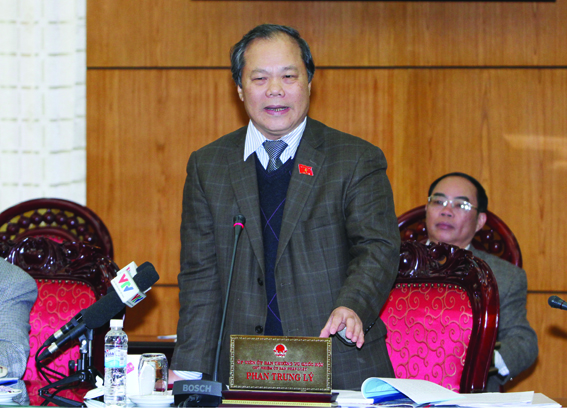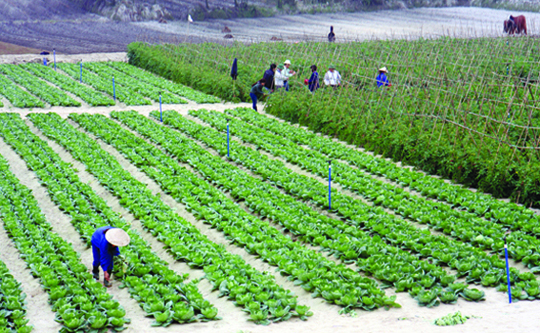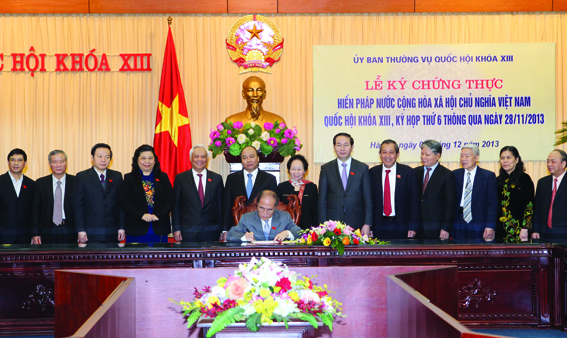Dr. Tran Du Lich
National Assembly Economic Committee
In the course of improving socialist-oriented market economy institutions, it is necessary to be clearly aware of the following three key issues:
(i) It is necessary to renew thinking and action in the performance of the State’s function of economic management from central to local level under the operation conditions of the market. This is a relatively difficult and complex issue in the process of shifting from a centrally planned economy to a market economy. State management in a market economy includes not only creating a transparent and open legal environment for the operation of market players but also remedying inherent defects of the market in order to promote the combined strength of the roles of the State and market.
(ii) Vietnam’s market economy can use the long-developed market tools which are suitable to its socio-economic conditions. Market mechanism operation institutions cannot be created separately for a particular country but they basically are universal, compliant with market rules, and the managerial knowledge accumulated by the mankind. Market is a tool and a mechanism for achieving the development goal of a nation, but not an objective per se. Therefore, the use of market economy tools is not contradictory to the socialist orientation in Vietnam’s economic model.
(iii) As an inherent characteristic of the market economy, conflicts of interest often emerge among different market players (e.g., no economic-financial policy of the State can satisfy the interests of all subjects it regulates), and interest groups often seek to impact managerial policies and institutions.

in Bach Ho (White Tiger) oil field__Photo: Huy Hung/VNA
The State should effectively use market tools but should not replace the market
The State should use market tools to guide the operation of economic actors to serve social and environmental protection objectives. Sustainable development should be a top priority in dealing with the defects of the market economy. The obvious manifestation of this trend is that the State should not do what the market can do but should remedy the defects and failures of the market. For instance, education and health are services falling within the State’s function but not the market’s.
Both positive and negative impacts of the market have spread beyond the national boundaries and become regional and international issues. Therefore, market institutions of a nation must be compatible with the institutions of international and regional economic and financial organizations in order to ensure the smooth operation of the market. The dependence of developing economies on developed countries has gradually decreased while their interdependence is on the rise.
The State should neither subsidize nor create risks for businesses with its administrative decisions. At present, Vietnam’s legal system on market economic management, albeit not perfect, has covered almost all fields. However, the effect and efficiency of the state management are not high because the State’s interference at different levels of administration does not fit market developments. On the other hand, the State still lacks supervisory tools and mechanisms as well as penalties to make sure that market players follow the “playing rules”.
The question is not whether the State or the market is greater but is how and with which tools the State should interfere in the market in ways suitable to its functions without distorting market relations.
Improving mechanisms for operating various markets
Improving the socialist-oriented market economy model and realizing national industrialization and modernization are two aspects of the same issue. To solve the development problem of Vietnam is to solve the problem of its market economy model. Over 30 years’ renewal, especially since the IXth National Party Congress, the issue of improving socialist-oriented market economy institutions has received constant attention and continuously been institutionalized in the legal system. Nevertheless, how to make economic institutions truly a momentum for the national industrialization and modernization remains a challenge. In the immediate future, it is necessary to improve the operation mechanisms of five types of market.
Theoretically, a market economy is operated on “three legs”, i.e., it is composed of three main markets, namely commodity market, capital market and service market. These three markets are interrelated and reflect the development level of an economy. In Vietnam, though having been formed and developed to different extents, these three markets share a common characteristic being the lack of synchrony among them and within each of them. Based on these three types of market, the IXth National Party Congress has identified five types of market in Vietnam and set the requirement for improving them.
In terms of development history, the commodity market (consisting of the material market and consumer goods market) appeared first, followed by the service market (notably the labor market and real estate market) and later the capital market (or, in a broad sense, the financial market, which is composed of the medium- and long-term capital market and the monetary market). In Vietnam, the development of these types of market is uneven among localities. So, the improvement of different types of market in the country should adhere to two principles. The first principle is to ensure synchrony in economic relations among the markets because none of them cannot develop separately and one market is the cause and outcome of another. For example, if other economic sectors are not developed, there is no condition for the financial market to develop and if the financial market is not developed, there is no capital source for other economic sectors. The second principle is that development of markets must be based on state policies and assured by relevant legal systems to achieve socio-economic development objectives set for each stage of the national industrialization and modernization process. These two principles should serve as a basis for assessing the synchrony and development level of each market in the economic structure of Vietnam. At the same time, through the current relevant legal systems, it is possible to point out necessary improvements for the five markets as follows:
(1) The financial market:
To improve a type of market means to improve its three constituents, namely supply constituents, demand constituents and supply-demand intermediary activities. The current laws on credit institutions, securities and insurance, etc., have relatively fully institutionalized financial, credit and banking institutions and non-bank financial and credit institutions operating in the economy. Specifically, commercial banks, financial companies, investment companies, investment funds, fund management companies, securities companies, insurance companies, credit cooperatives, etc. are all regulated by relevant laws.
First of all, direct interference with administrative tools should be shifted to indirect interference with market tools. The relative independence of the central bank should be enhanced in the monetary market management. An independent institution performing the State’s supervision of the whole financial market should be created. Non-bank financial and credit institutions should be developed to supply capital for the market. More sanctions should be imposed on financial and credit institutions that pose risks to the market. A separate law is needed to regulate non-bank financial and credit institutions for linking the operations of the two main markets in the financial market, namely capital and monetary markets. A national market watchdog should be created to give market information, forecasts and warnings and supervise and impose sanctions on players in this market.

Photo: Phuong Vy/VNA
(2) The real estate market:
The real estate market is a specific market which is experiencing unhealthy developments. The real estate market generally consists of all three types of market, namely the trading and transfer market, the lease market and the mortgage market. By nature, the real estate market is classified into primary market and secondary market. The primary market is formed through the process of building new technical infrastructure facilities and architectural works such as building new urban centers; conducting urban embellishment; building houses, industrial parks, offices for lease, and hotels, etc. The secondary market is formed through transactions (purchase and sale, lease and mortgage) arising in the course of operation of the real estate market. These two markets are closely interrelated.
The “freezing” in the real estate market in the past years is seen mainly in the secondary market, mostly in trading and transfer transactions. To develop the real estate market in a healthy manner, it is necessary to deeply analyze each of these markets and identify factors that directly affect each market so as to come up with appropriate policies. The whole legal system concerning the real estate market should be scrutinized for comprehensive revision. Financial and planning tools must be used to direct the market and combat speculation.
(3) The commodity market:
Vietnam’s commodity market has seen a relatively high growth rate over the recent years. However, in order to develop this market to be modern and conformable with the regional and international integration process, it is necessary to focus on:
(i) Building and developing a central commodity market toward a futures market. A central commodity market is the place where goods purchase and sale contracts are traded among commercial businesses participating in the commodity market. Goods purchase contracts are signed between purchasers and sellers with the purchase price of each unit of goods specified under future delivery conditions. Particularly for farm produce, as farmers suffer heavy risks caused by natural conditions, part of market risks should be shifted to traders. In other words, the market itself, but not farmers, must bear market risks. Building a central commodity market for futures contracts should give priority to agricultural products and production materials. Even imported consumer goods can be traded in a futures market to prevent impacts of price fluctuations on consumers. For example, petrol and oil, iron and steel and fertilizer traders must participate in the global central commodity markets for trading futures contracts and bear responsibility for market price risks.
(ii) Developing local goods distribution networks. In line with the common trend of the commodity market, Vietnam’s traditional modes of goods purchase and sale will be gradually replaced with modern forms of purchase and sale like supermarkets, general trade centers or specialized trade centers. At present, new and modern modes of trading just account for around 20% of total retail sales in the country. Modern retail forms have recently developed rapidly in major cities with the participation of international retail groups.
International retail groups are penetrating into the markets of developing countries to dominate local retail markets. With their distribution networks, these groups exert strong influences on manufacturers and suppliers. Though Vietnam’s WTO commitments impose certain limitations on foreign retail groups doing business in the country (e.g., the Government retains the right to license from the second retail establishment on of these groups in the Vietnamese market), foreign retail groups always aim to establish the whole distribution system but not a single retail establishment. That foreign retail groups step by step dominate the domestic retail market poses a challenge to Vietnamese businesses, so it is necessary to prioritize the development of domestic retailers and encourage the formation of Vietnamese retail groups and building of modern retail systems. This is a pressing as well as long-term issue that needs due attention in developing the country’s commodity market.
(4) The labor market:
Labor is a special commodity. The improvement and development of the labor market in synchrony with other markets will significantly contribute to mobilizing human resources for sustainable development. Thus, in the process of improving the labor law, renewing training policies in response to market requirements and carrying out fundamental and comprehensive reform of education and training in line with the Resolution of the XIth National Party Congress, special attention should be paid to the quality of trained labor to meet the requirements of industrialization and modernization and serve the switch from use of cheap labor to use of high-quality labor.
(5) The technology market:
To improve and develop the technology market, focus should be placed on the following four groups of policies and measures:
(i) Policies to promote economic restructuring should be compatible with science and technology development policies in each field and locality. For instance, in implementing WTO commitments to slash import duty rates, investment to increase scientific and technological content in the value of products, goods and services is a decisive factor for businesses in raising their competitiveness on the market. Tax incentives should be granted to businesses that venture on the application of local technologies to develop new products or shift from processing for foreign parties to manufacturing components and accessories. This will help promote the development of the technology market and improve the competitiveness of the economy.
(ii) The use of state budget funds for science and technology should be renewed as follows: Research should be conducted based on specific orders and final products should be tested before acceptance. Payment for research findings must be based on actual expenses but not on administrative norms. State budget funds should be concentrated on several key fields rather than be thinned out. Financial mechanisms should take into account the interests of businesses and scientists. Autonomy and accountability of organizations and individuals taking part in scientific and technological research should be raised.
(iii) Venture investment funds should be set up in the field of science and technology. Businesses should be encouraged to make venture investment in the application of new technologies.
(iv) The State should promote and support technology creation activities of scientists and promote the formation of technology business incubators and e-commerce hi-tech incubators as well as the formation of science and technology businesses. State policies on funding for science and technology should be changed from providing subsidies for inputs to financing scientific and technological products.

(VEAM) Corporation__Photo: Danh Lam/VNA
Using planning tools in the market economy
Planning work should be renewed to clearly define socio-economic contents that each level of administration should plan. At the same time, resources should be calculated and arranged corresponding to the set objectives, aiming to direct the development of the market. Renewing planning work is in essence redefining the role of the State throughout the process of directing the market to develop according to the objectives set by the State. Therefore, an important task of planning work is to forecast factors that affect the development objectives.
It is necessary to renew the current content and methods of determining socio-economic targets from prescription to forecasting. For example, such economic targets as economic restructuring, raising of investment capital, consumer price index… should be regarded as forecasts to guide investors in their activities and but should not be seen as mandatory targets set by the State in the administration of the economy. Planning work should focus on formulating national and local target programs which identify policies, measures and solutions to achieve the set objectives.
Regarding socio-economic development targets, it is necessary to concentrate on sustainable development targets like social security and environmental protection, with a view to forcing all levels of administration to accomplish their tasks. Economic targets are just the means, only social security targets are the goal of development.
Breakthroughs needed in administrative reform and public finance
Decentralization of power to localities should be expanded at the same time with creating mechanisms to enhance the examination, inspection and supervision by the central government of local administrations. Specifically, the Government should focus on three tasks: (i) making policies; (ii) promulgating regulations, and (iii) examining, supervising and punishing violations. Specific decisions related to the economic life of each locality should be left to local administrations to make.
Decentralization should ensure the unity of national administration and the characteristics of a unitary state while upholding the initiative of localities on the basis of the comparative advantages and competitiveness of localities, economic regions and urban centers. The common trend in the world is increasing autonomy in budgetary control and provision of urban services of municipal administrations.
Decentralization should be implemented in the direction that any work that subordinates or localities can perform well should be assigned to them. Tasks and powers should be assigned to levels that can perform more properly and more effectively and have better conditions for performance.
Administrations should take full responsibility for their tasks and have full competence (self-decision and autonomy for assigned tasks; no overlapping work between the central and local administrations and between different levels of administration in a locality in order to avoid buck passing, confusion and obstruction in their activities).
The administration which is currently burdened with management purposes and subsidizing civil liability of citizens should be changed to a service one. In the market economy, the State should not manage society with the method of subsidizing civil responsibility of citizens, or in other words, administrating civil relations, but it should raise the role and responsibility of citizens in civil relations. Judicial administrative procedures provide a typical example of this problem. In these procedures the State seems to perform citizens’ responsibility in such civil relations as notarization, enforcement of civil judgments, civil status, etc. The thinking of subsidization by the State of responsibilities in civil relations has left a heavy imprint on relevant legal systems. This way of management is no longer suitable to the characteristics of a market economy and makes the state administration apparatus cumbersome and inefficient.
On the basis of the 2013 Constitution, the above-mentioned principle of decentralization and delegation should be incorporated in the Law on the State Budget, the Law on Organization of the Government, the Law on Organization of Local Administrations; and the characteristics of rural, urban and island administrations should be institutionalized in line with the Resolution of the Xth National Party Congress.
A service administration should be built on the basis of establishing public service delivery organizations. At present Vietnamese law has no provisions on non-profit public service delivery organizations. Non-profit public service delivery organizations are essentially those providing public services for the society such as health, education, cultural, science services, urban services, legal aid, information support, agricultural and fishery extension services, etc., which are invested by different economic sectors and the State to serve common interests of the society and community. These investors do not keep profits for themselves (which does not mean that these organizations do not conduct business but they conduct business to accumulate capital for constant development). In order to play this role, the State should early promulgate a law on non-profit public service organizations providing that the State has the role of supervising activities of these organizations, but does not assume the role of these organizations.
Viewpoints on development of medium- and small-sized enterprises
At present, medium- or small-sized enterprises account for more than 90% of around 500,000 businesses operating under the Law on Enterprises in Vietnam. Among more than 3 million production households (not registered under the Law on Enterprises) in the sectors of industry and construction, and trade and services, an overwhelming majority are medium- and small-sized ones.
The question here is, in the development strategy, which forces should we rely on and develop: economic groups or medium- and small-sized businesses? If combining both, how should this combination be made? This question should be answered in Vietnam’s development policy, which will be expressed in each relevant law and in the system of supporting institutions of the State. There should be a separate law on medium- and small-sized enterprises (like Japan).
Development of supporting industries is vital for the economy when it participates in the global value chain
The value chain to create goods and services is composed of three stages: (i) research, designing and manufacture of components, accessories and details of products; (ii) manufacturing including processing and assembly to make finished products; and (iii) distribution and sale. In these three stages, the first one yields the highest added value and the second one brings about the lowest. Vietnam’s industry is largely in this second stage. The industrialization strategy should direct the economy to the first stage and participate in the third stage. This is the primary content of the objective of economic restructuring. A law to encourage development of supporting industries should be early promulgated.
The foundations for industrialization: agriculture, farmers and rural areas
The weaknesses of Vietnam’s agriculture lie in its product structure, mode of production organization and underemployment status. Restructuring in agriculture should focus on the labor structure, but not value structure. Concerning this viewpoint, there arise many crucial questions such as whether maintaining the model of farmer households or developing a large-scale agriculture would be more effective. Other questions are concerned with the mode of production organization, policy on risk reduction in agriculture under market conditions; application of biotechnology in cultivation and farm product processing; training to shift labor from agriculture to non-agricultural sectors; change of the use purpose of agricultural land in rural areas, etc. The thinking of provincial economic structure should be abolished. The problem of turning fertile rice fields into industrial parks or urban centers should be prevented. Production and population should be arranged across economic regions. Policies should be adopted to help farmers engaged in specialized rice cultivation (two or three rice crops per year) improve their living standards to be at least equivalent to those of industrial park workers. Agro-industrial clusters should be built on a regional scale in order to increase the value of farm produce.
PPP model in investment
Public-private partnership is a model of investment by which the State compensates the investor for the economic benefit brought about by the project which does not yield direct financial benefit to the investor. At present, many investment projects are implemented by this mode in our country to build infrastructure facilities, such as transport and water supply projects. Under this form of investment, budget capital is used to attract investment from the private sector. However, the highest legal document on this model is just a prime ministerial decision, which causes legal risks to investors. Therefore, a law is needed to institutionalize this form of investment. Once this form is developed, many types of public services and commodities would attract private investment and reduce the number of state enterprises operating in these fields. With the form of investment, the State can complement the market, fulfilling its function in economic management.
Conclusion
Renewal of economic institutions is an issue that has been raised for many years and is now considered a strategic breakthrough. However, it has not yet brought recorded satisfactory results as expected. The reason is that Vietnam still lacks a systematic view on its model of industrialization and a clear development philosophy for forming a suitable system of institutions. An apparent consequence is that its economic laws are very short-lived.
Vietnam is participating extensively and deeply in the globalization process and integrating deeply in the regional and world economies. This is an opportunity which Vietnam must seize in order to achieve the objective of national industrialization in the shortest path. At the same time, it is facing the risk of falling into the middle-income trap.
Institutional reform should have appropriate steps which must not cause legal conflicts and policy contradictions. The priority and pressing issue in the ongoing institutional reform is thoroughly reforming public finance and public administration. Without doing this, all other reforms would bring not any effective results. On the basis of the new Constitution, these two vital reforms can be carried out successfully.-









